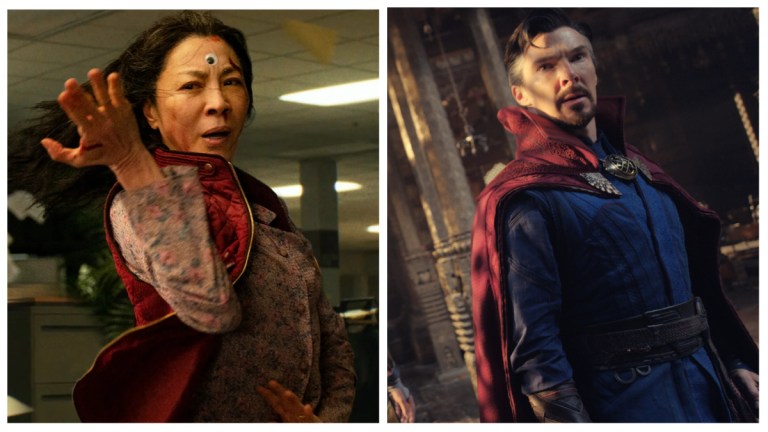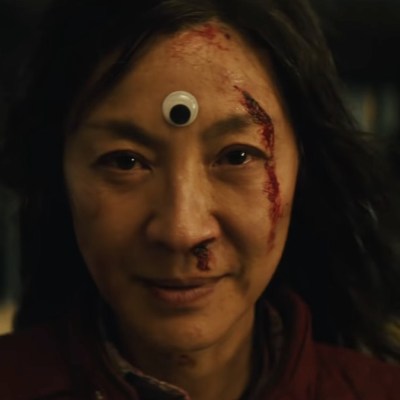Everything Everywhere, Doctor Strange, and Why We Now Love Multiverses
The multiverse concept has exploded in popularity recently with movies like Everything Everywhere All at Once and Doctor Strange in the Multiverse of Madness. Why?

This article contains mild Everything Everywhere All at Once spoilers.
Everything Everywhere All at Once has just arrived to streaming, but the Daniels-directed indie darling is only the latest (and let’s be honest, best) in a recent flurry of activity across the multiverse.
The film was the first of several major releases to feature the multiverse this year, opening just slightly before Doctor Strange in the Multiverse of Madness, which in turn was the second multiverse movie to feature Doctor Strange after Spider-Man: No Way Home, which itself was the second multiverse-themed movie in recent years to feature Spider-Man (with two more sequels to that version of the multiverse on the way). Most of the narrative in these projects, it should be added, were also kick-started last year by the Disney+ series Loki, which made a major plot point out of introducing the multiverse to the Marvel Cinematic Universe.
Additionally, the MCU isn’t the only place that’s experienced a multiverse explosion. We also have the new Flash movie coming out next year (assuming Ezra Miller doesn’t make its publicity even more toxic by then), which will be adapting the Flashpoint storyline from the comics, throwing Barry Allen into an alternate universe and leaving behind Ben Affleck’s Batman to do a team-up with Michael Keaton’s. Of course Miller’s Flash has also had a brief cameo in CW’s Arrowverse mega-crossover event Crisis on Infinite Earth, another multiverse event by a different name.
And before any of these projects were greenlit, there was Dan Harmon and Justin Rolland’s Rick and Morty, which has featured numerous variants of its protagonists in a tightly controlled set of allowable timelines since its first season way back in 2013. In fact, according to the writers of Everything Everywhere All at Once, Daniel Kwan and Daniel Scheinert, the combo of Rick and Morty and Spider-Man Into the Spider-Verse very nearly killed Everything Everywhere before it started.
“As we were working on the movie, Spider-Man: Into the Spider-Verse came out,” Kwan said in one interview. “It was a little upsetting because we were like, “Oh shit, everyone’s going to beat us to this thing we’ve been working on.”
Scheinert added that he thought Rick and Morty came first and Kwan agreed, “I was like, ‘They’ve already done all the ideas we thought were original!’ It was a really frustrating experience. So I stopped watching Rick and Morty while we were writing this project.”
And yet, the multiverses keep coming. So… why has this once obscure bit of theoretical science (and nerdy science fiction) become so deafeningly popular? After all, it does feel like the concept is now everything, everywhere… all at once.
A Very Brief History of Multiverse Science and Philosophy
The multiverse is a theory that has always had a wide appeal among a certain type. The term was first coined by Michael Moorcock in 1963 and has shifted and changed a lot in its interpretations throughout the decades. Sometimes it just means “lots of other universes existing outside our own” with their own laws of physics. However, a very common interpretation is a (probably wildly inaccurate) reading of the “many worlds” theory of quantum mechanics where each probable outcome of random chance spawns an alternate timeline. The best example of this theory in fiction is the episode of Community (by Rick and Morty co-creator Dan Harmon) titled “Remedial Chaos Theory.” In that episode, we see how one roll of the dice yields seven alternate outcomes.
Everything Everywhere All at Once, meanwhile, was inspired by the more philosophical school of thought called “Modal Realism,” which was proposed by philosopher David Kellogg Lewis. This concept argues that “possible worlds” are no less real than “actual worlds.” If it’s possible to think of, it exists.
Whatever the scientific or philosophical background of the idea, however, these are usually just hand-wavy excuses to get to the old question of “What if things had turned out differently?” And in recent years, first in comics, then later in television, and now in movies, it has also helped answer another question:
How Can We Make Money by Combining These Two Lucrative IPs Which Have Contradictory Back Stories?
One of the first big mainstream uses of the multiverse was the “Crisis on Two Earths” storyline told in DC Comics’ Justice League of America circa 1980. That multi-issue arc brought together Wally West and Barry Allen’s contradictory Flash backstories. Since then, comic book crossovers and retcons have piled one on top of the other, culminating in stories such as “Crisis on Infinite Earths” at DC which retconned just about every DC story that came before it. Meanwhile Marvel Comics’ more recent “Secret Wars” storyline from 2015 destroyed every single world in the Marvel multiverse, including the “prime” 616 universe. (Don’t worry, it got better.)
It’s a trick that’s been adapted to television, with ever-escalating Arrowverse crossovers, culminating in their own Crisis on Infinite Earths storyline, which included the Arrowverse, the universe of Supergirl and Superman & Lois, the original 1960s Batman series, the “prime” Arrowverse future, a mash-up of previous versions of Batman, old canceled TV shows like Constantine, Lucifer, and Smallville, and even Zack Snyder’s version of the DCEU via the aforementioned Ezra Miller cameo.
And now in the world of movie franchises stacked atop each other, the multiverse concept creates a storytelling loophole where you can bring back Tobey Maguire and Andrew Garfield’s Peter Parkers to visit the MCU alongside Tom Holland (as well as a brief visit by Sony’s “Venomverse”).
Even Space Jam: A New Legacy uses its “server-verse” concept to (finally) allow Bugs Bunny to hang out with the likes of the Iron Giant and the droogs from A Clockwork Orange…
A New Perspective
The above is the most cynical way to view the newfound popularity of the multiverse concept, but to look at things a bit more charitably, the multiverse also allows lots of different interpretations of long-lasting legacy characters to stand alongside each other, validating each equally. In Dan Slott’s original Spider-Verse comics, we got to see the ‘60s, ‘90s, and modern animated versions of Spider-Man team-up alongside each other. In those comics, and the 2018 animated movie it inspired, we also glimpse a gritty, noir take on Spider-Man standing alongside a cartoon pig version of Spider-Man. And here’s the thing: We get to see what they have in common.
With established characters, the multiverse can be used as a kind of narrative Jenga, taking away every well-known aspect of them to find out what elements are essential to leaving the character still standing.
Spider-Man can have organic web-shooters or make his own; he can be Peter Parker or Gwen Stacy or Miles Morales; he can drive a giant mech and still be Spider-Man. But through these stories we see that he always has regrets. He always tries to do the right thing even (or especially) when it’s hard, but he always kinda messes it up too.
In the same way, with Doctor Strange in the Multiverse of Madness and the Disney+ anthology series What If?, we see Doctor Strange keep making the same mistakes over and over again, through arrogance, through a need to control everything, and through an inability to see his own limits.
One of the best episodes of Rick and Morty is the episode set on the Citadel, a multiversal fortress inhabited entirely by Ricks and Mortys who fulfill every role in every stratum of society, with a selection of different stories that each repeat the same characteristics and dynamics. And once again, Everything Everywhere All At Once shows us that no matter how different the choices Michelle Yeoh’s Evelyn made are, and how separate each variant life she leads is, they still contain echoes of the same conflicts, the same internal demons she needs to fight.
We live in a multimedia age where every character is viewed through multiple perspectives and multiple interpretations, and the idea of a single overarching narrative or canon is to be treated with suspicion (perhaps there’s a reason why Doctor Who, whose canon is already wildly self-contradictory, has only ever paddled ankle-deep in these waters).
The Darkest Timeline
But there might be another reason so many of us are looking to these narratives at the moment. Since 2016 a phrase that has seen a lot of use is “The Darkest Timeline.” It’s a reference to the Community episode we already mentioned, where the wrong dice roll leads to a timeline where Pierce has died, Annie’s been institutionalized, Jeff has had an arm amputated, Troy destroyed his larynx, Shirley’s an alcoholic, and Britta has that blue streak in her hair. Also, of course, Abed insists everyone should grow evil goatees (a reference to the OG alternate timeline story, Star Trek’s “Mirror, Mirror”).
The point is that over the last few years there has been a growing feeling that the world has gone wrong. Trump, Brexit, climate change, Ukraine, a global pandemic, mass shootings, take your pick.
As Ke Huy Quan’s Waymond says in Everything Everywhere All At Once, “You’ve been feeling it too, haven’t you? Something is off. Your clothes never wear as well the next day. Your hair never falls in quite the same way. Even your coffee tastes wrong. Our institutions are crumbling. Nobody trusts their neighbor anymore. And you stay up at night wondering to yourself…” and Evelyn finishes his sentence, “How can we get back?”
It’s not just that bad things keep happening, although these stories do reach for that lingering sense that things aren’t going the way they’re supposed to. But it is also that there are people around us who seem to exist in completely different realities. How else do you explain that attempts to stop the spread of a deadly virus are considered a form of oppression, that the U.S. presidency has somehow been “stolen,” that LGBTQIA+ people are called “groomers,” and climate change is considered by millions to be a “hoax?”
Another recent series to delve into alternate timelines was the adaptation of Lauren Beukes’s Shining Girls, where a survivor of an attack by a time-traveling serial killer discovers her reality frequently changes in ways that only she notices: her haircut, her job, even her address can shift instantly and without anybody else realizing it.
In a world of constantly conflicting narratives, when the pandemic has isolated each of us in our own bubbles for a long period of time, it’s not hard to see why this perception of a fractured reality has resonance. Perhaps we just want to get back to the “Prime” reality or escape it to a better one.


